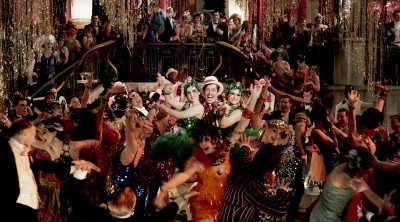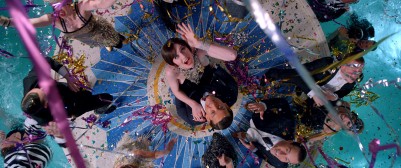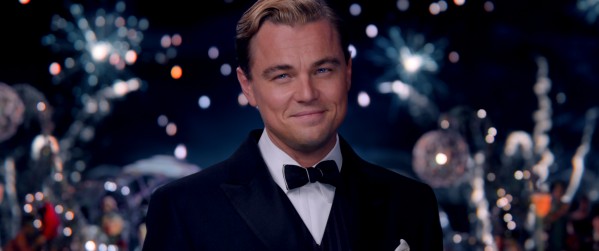When F. Scott Fitzgerald was writing The Great Gatsby, he wasn’t doing it from memory but from current experience. The novel chronicled the Jazz Age, as well as frenzy of money-grubbing on Wall Street that would unravel before the end of the decade, as it was happening. And yet the novel has always conveyed the wistful wooziness of remembered halcyon days with the bitter tang of regret still on the tongue — A la recherchez du temps perdu.
The book, though, didn’t really catch on until after Fitzgerald’s death, when, with the benefit of hindsight, readers could appreciate his prescience, his exactitude in painting vivid word pictures of the excess and glamour of the Roaring Twenties.
Baz Luhrmann likes picture-pictures more than word pictures, as evidenced by his feverish, stylized films about young lovers (Romeo+Juliet, set in the modern day) and le belle epoque (Moulin Rouge, with its rock score). After the boondoggle that was Australia, he’s back to his roots, emphasizing the spectacle of the the ’20s as only he can.
 There’s the risk, then, that he would replace Fitzgerald’s precise and elegant loquaciousness with garish images for the film adaptation of The Great Gatsby (out today in wide release), sacrificing its literary bona fides in the process. Admittedly, I more or less expected that going in. (The film was bumped from its Christmas opening date last year for the unenviable position of being sandwiched between Iron Man and Star Trek to allow more work on the 3-D effects — news that didn’t breed high expectations for fans of the book.) But Luhrmann has stayed remarkably true to the tone and scale of the novel, and if his images replace the ones in our mind’s eye, well, he does so with conviction.
There’s the risk, then, that he would replace Fitzgerald’s precise and elegant loquaciousness with garish images for the film adaptation of The Great Gatsby (out today in wide release), sacrificing its literary bona fides in the process. Admittedly, I more or less expected that going in. (The film was bumped from its Christmas opening date last year for the unenviable position of being sandwiched between Iron Man and Star Trek to allow more work on the 3-D effects — news that didn’t breed high expectations for fans of the book.) But Luhrmann has stayed remarkably true to the tone and scale of the novel, and if his images replace the ones in our mind’s eye, well, he does so with conviction.
The best scenes in The Great Gatsby are often the ones that go over-the-top; the mysterious bootlegger Gatsby (Leonardo DiCaprio) makes his entrance fully half an hour into the film, in what is surely one of the masterful character introductions of all time, right alongside Harry Lime in The Third Man: Leo’s angelically square-jawed face, haloed by a slick of blond hair as fireworks burst behind him to the strains of a live band playing Gershwin’s Rhapsody in Blue.
If your first thought is that Rhapsody wasn’t composed until nearly two years after the story is set, well, you’ve totally missed the aesthetic of a Baz Luhrmann photoplay. Naturalism gives way to a kind of shoe-horned realism, just like it did in Moulin Rouge: Hence not only is Gershwin anachronistically inserted, so are songs by Cole Porter, Fats Waller … and Gotye, Lana del Rey, Jay Z and more. Don’t get hung up on the authenticity; instead, allow yourself to believe in the magic.
The Great Gatsby often is magical, with the diaphanous glitz of a fever-dream, as told by literature’s most detached narrator, Nick Carroway (Tobey Maguire, in probably his most mature and unaffected performance). You can overlook DiCaprio’s strange accent (Gatsby was, after all, his own creation — like 20th century America itself — so why not speak like no one else?) and even the unusual architecture (Gatsby’s castle is less Long Island than Newport) and revel instead in the spectacle.
 Luhrmann mixes beauty with brutishness, especially in the personage of Tom Buchanan (Joel Edgerton), the husband of shallow Daisy (Carey Mulligan), whom Gatsby has pursued across time and achieves great wealth merely to woo her back. But Luhrmann also shows Daisy’s selfish side without compromise.
Luhrmann mixes beauty with brutishness, especially in the personage of Tom Buchanan (Joel Edgerton), the husband of shallow Daisy (Carey Mulligan), whom Gatsby has pursued across time and achieves great wealth merely to woo her back. But Luhrmann also shows Daisy’s selfish side without compromise.
The film is a sure-fire contender in next year’s Oscar race for design awards (deserved), but the good news its that is not just pretty (the 3-D effect doesn’t add much; don’t waste the extra money) but emotionally satisfying even to devotees of the novel. Finally, a film version of Fitzgerald that succeed in both beating on, borne back ceaseless into the past, while paving the way for the future.
Three stars. Now playing in wide release.
















